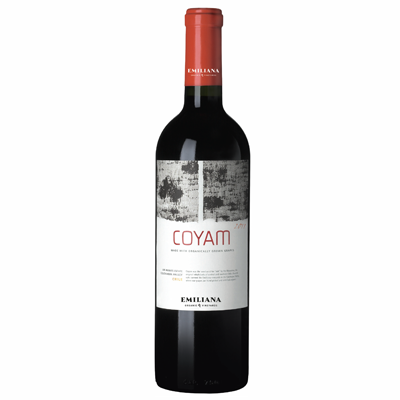Your shopping cart is empty!
Categories
Coyam Vintage 2011
SGD $0.00
Qty:
| Varieties: | 38% Syrah, 31% Carmenere, 19% Merlot, 10% Cabernet Sauvignon, 1% Mourvedre, 1% Malbec |
| Bottling Date: | February 2013 |
| Alcohol: | 14.6˚ Vol% |
| Residual Sugar: | 2.04 gr/lt |
| Total Acidity: | 5.24 g/lt |
| pH: | 3.59 |
| Total SO2 at bottling: | 0.080 g/lt |
| Vineyards: | Los Robles, planted on the foothills of a mountainous outcropping in Lo Moscoso. |
| Vineyard Description: | Located 245 m asl.Vertically positioned vines planted on their own roots (ungrafted) with a southern exposure.Vines produced from massal (field) selections of different varieties, except forSyrah and Merlot, which are clones 300 and181, respectively. Most of the vineyards havean east-west orientation because they were originally furrow irrigated. Drip irrigation was introduced in 2000, which enabled new plantations and a change in orientation in search of the best exposition. |
| Plantation year and density: | 1992 and 1995, 2,667 plants/hectare; 1998 at 3,333 plants /hectare, and 2000 at 4,166–5,000 plants/ha. |
| Yield per hectare: | 6 ton/ha. / 39 Hl/ha. |
| Of colluvial origin in the Coastal Range. Deep with abundant stoniness and 3% organic matter (low-medium level). The texture ranges from clay-loam to silty-clay-loam, which lends mineral complexity. The texture also provides the soils with a high capacity for moisture retention. The pH is slightly acidic (5.8–6.2). | |
| Climate: | Average temperatures are 22ºC, and summers have a high daily temperatureoscillation. Temperatures during the 2010–2011 season were lower than in past years.The fruit ripened almost simultaneously,approximately one week later than it did inthe previous season, which increased the harvest speed toward the end. Precipitation was just 330 mm, which corresponds to a 40% decrease in rainfall. Rain fell throughout the entire year, except February, which was the only dry month; June was the rainiest. Despite the rain, the grapes reached harvest in very healthy condition, with firm skins, high acidity levels, tremendous concentration of color and total polyphenols, and lower sugar content. All of this resulted in fresher wines with lower alcohol levels and tremendous personality. |
| Harvest: | Manual, between April 6 and May |
| Winemaker: | Alvaro Espinoza. | |
| Vinification Cellar: | Los Robles. | |
| Vinification: | The reception included a triple selection using conveyor belts before andafter passing through the destemmer-crusher.The grapes then dropped gently (by gravity) into the fermentation tanks, where they underwent a 5-day pre-fermentation cold soak at 6ºC. Alcoholic fermentation took place in stainless steel tanks with native yeasts at 26ºC with a program of pumpovers determined by enological criteria. The new wine remained on its skins for a 7-day postfermentation maceration at 22º–25ºC, for a total maceration (skin contact) time of 25-28 days. Malolactic fermentation took place naturally in barrels. The wine was then aged for 13 months. The wine is stabilized naturally,without treatments, and is only very lightly filtered at bottling with a 3–5 micron (absolute) cartridge. | |
| AgEing: | 13 months in oak barrels, 80% French and 20% American. | |
| Production: | 19.933 cases (9 lts) | |
| Aging Potential: | 10–14 years | |
| Tasting Notes: | Deep purplish-red in color, with intense aromas that recall cherries and strawberries delicately blended with notes of tobacco, cedar, and rosemary with a light touch of smoke. Juicy on the palate, with sweet, ripe tannins that lend good structure and volume. Fresh and elegant with a lingering finish. Recommended for aging. |
|
| Food Pairing: | This is a complex wine that needs intense preparations such as grilled red meats, including wagyu, beef, or lamb, served with potatoes au gratin, rice, or spicy sauces. Decant before drinking and serve in Bordeaux-style glasses at 18ºC. |
 |
Organic agriculture Certified. IMO, Switzerland. |
 |
Social Responsibility Certified. IMO, Switzerland. |
 |
Carbon Neutral Certified. TÜV SÜD, Germany. |
.png)

